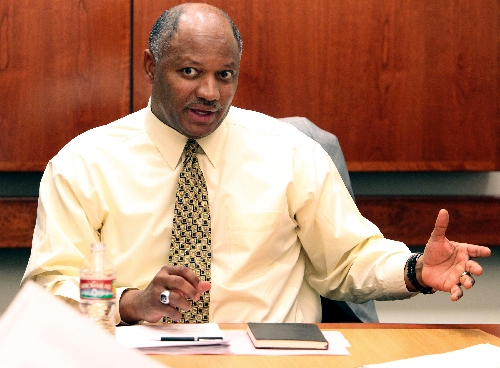New ratings leave no school behind, push many to top
On paper, Booker Elementary School is exceptional, exceeding standards with four out of five stars, according to the district's assessment.
But only slightly more than half the students at the school on Martin Luther King Boulevard near Carey Avenue scored at grade level on state tests in reading and math during the 2011-12 school year, according to the Nevada Department of Education.
Those poor state test results and other factors would have dropped Booker's rating to two stars. That would mean it was failing to meet standards under Clark County School District's new, self-created assessment system replacing the federal benchmarks of No Child Left Behind.
But school district officials didn't take away any of Booker's four stars from 2010-11 because of its poor performance in 2011-12.
And Booker wasn't alone.
Sixty-three other schools would have been downgraded because of declining performance in 2011-12, but the district disregarded those scores.
Instead, the district allowed the schools to keep their 2010-11 rankings for the 2011-12 School Performance Framework.
The decision angered some School Board members, like Rene Cantu, who said the tactic "sticks in my craw."
"The way it's done artificially inflates the amount of schools who are rated highly," Cantu said of the scoring technique based on a "hold harmless" rule. It allows schools that improved to earn more stars in 2011-12, while not deducting stars from schools that lost ground.
No Child Left Behind also had a form of a hold harmless rule that required two consecutive years of failing scores before a school's designation was lowered, Superintendent Dwight Jones said in defense of the district's system on Friday.
The reason for a hold harmless year is that one year of decline may be a fluke, said Assistant to the Superintendent Ken Turner, making the analogy that a carpenter measures twice and cuts once.
However, No Child Left Behind also required schools to meet standards two years in a row before being upgraded. The district raised rankings for improving schools immediately.
Therein lies the problem, Cantu argued.
"If it's going to be sticky, it has to be sticky in both directions," he said.
Since it's not "sticky" in both directions, school performance looks better for 2011-12 than it actually was. That is why a whopping 91 Clark County public schools, or 28 percent, earned five stars and none earned just one star for poor performance.
So, why did the district set up its hold harmless rule to benefit improving schools while those that did worse got a pass?
The rationale, according to Jones, is that the rating system is just in its second year. Making it "punitive" this early on by downgrading schools would be a disservice, he said.
"If we make it punitive, people (principals and school staff) will turn their backs on the system before giving it a chance," Jones said.
ACTUAL RATINGS ON WEBSITE
But education advocates, such as Cantu, question whether an accountability system that rewards improving schools and hides schools in decline can be considered functional.
"I don't know how we can be accused of trying to hide it," Jones argued.
On the district website, parents can find their school and the actual ratings for 2010-11 and 2011-12, he said.
But to do so, parents would have to navigate past the "official" rating for 2011-12, which in the case of worsening schools is actually the 2010-11 rating.
"The system is transparent. It is not misleading," said a district statement released Friday.
However, school district officials didn't disclose the hold harmless provision when they unveiled 2011-12 school rankings to the press Thursday morning. It only provided the star ratings without explaining that only 72 of the 91 top-ranked schools earned five stars because of improved performance.
The rest of the five-star schools were allowed to keep their designations despite getting worse.
District officials also did not explain why no one-star schools were on the list.
Jones said the 64 schools that did worse last year but kept their stars would tell parents about their declines.
Whether this will indeed happen concerned senior School Board member Carolyn Edwards.
She agreed with Jones that the hold harmless rule serves a purpose, but said it shouldn't "mask" the truth.
"If on their school website, all they say is we're five star" that's a problem, she said, referring to the 19 five-star schools that would have been downgraded in 2011-12 without the rule.
These schools need to have gatherings with parents to discuss their lagging performances and not pretend their scores remained the same.
There are a lot of mixed signals that most parents won't pick up, even if they happen to be told, asserted Victor Joecks, spokesman for the conservative think tank Nevada Policy Research Institute.
If schools and the district want to be "transparent" about school performance, the rankings need to accurately reflect performance, period, he said.
School Board member Lorraine Alderman was adamant that the hold harmless rule not be permanent, although it may serve a purpose now.
And it won't be permanent, according to Jones. In the future, two years of data may be combined for a fuller picture, he said.
But if the system seems misleading in the rollout, it will be hard to shake that impression, Joecks said.
"Implementation is key," he added. "Don't mislead the public. That's the quickest way to eliminate trust."
Contact reporter Trevon Milliard at
tmilliard@reviewjournal.com or 702-383-0279.




























